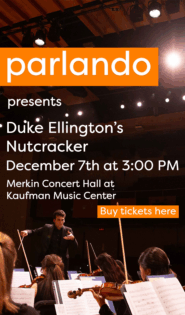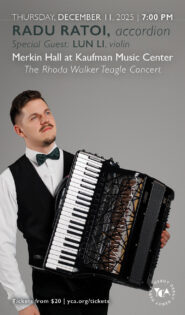Performances
Honeck, Pittsburgh Symphony make powerful Carnegie stand in Russian program
Manfred Honeck has led the Pittsburgh Symphony Orchestra as music director […]
New and old faces imbue Met’s “Porgy and Bess” with fresh drama and impact
Like a successful business enterprise, the Metropolitan Opera’s production of George […]
New York Youth Symphony opens season with thrilling stand at Carnegie Hall
The New York Youth Symphony opened its season Sunday afternoon in […]
Galilee Chamber Orchestra brings a mixed night of “peace through music” to Carnegie
Carnegie Hall is associated in the public’s mind chiefly with music, […]
Cage match: Aimard frames Benjamin premiere within a century of piano music
The night after Jean-Efflam Bavouzet played Le Tombeau de Couperin—and more Ravel—in […]
Articles
Critic’s Choice
Music of Prokofiev, Still, Ginastera, Blache. Sphinx Virtuosi. October 17. The […]
Opera Lafayette to premiere oldest known opera by black American composer
Sometimes finding a musical treasure is sheer serendipity. A librarian cleaning […]
Concert review
Kremer and Company evoke this world and the next in Pärt tribute

A Baltic breeze wafted through Carnegie’s Zankel Hall Thursday night, as a trio of Latvian and Lithuanian musicians paid tribute to Estonia’s favorite son, Arvo Pärt.
Violinist Gidon Kremer was the headliner, richly supported by cellist Giedrė Dirvanauskaitė and pianist Georgijs Osokins, in performances of three Pärt classics, before widening the program’s frame to include sympathetic works by Giya Kancheli and Rachmaninoff.
In this year of Pärt’s 90th birthday (which took place on September 11), music by the influential Estonian minimalist is being featured on several programs at Carnegie Hall. In Thursday’s dark-hued program, other composers’ meditations on mortality were leavened by Pärt’s visions of a spiritual realm beyond earthly strivings.
Pianist Osokins set the tone for the evening with Für Alina, a foundational work for solo piano in Pärt’s distinctive “tintinnabuli” style. In an atmosphere of deep concentration, pianissimo, a chant-like melody unfolded, along with its doppelganger at a distant interval, with such mathematical regularity that a single C sharp “out of place” sounded like a world-shaking event.
From that minimal solo, the Pärt section of the program seemed to open like a flower with the addition of Kremer for the violin-and-piano piece Fratres and finally Dirvanauskaitė for the piano trio Mozart-Adagio.
The much-arranged Fratres was heard here in its original duo version, Kremer introducing it in a soft whir of string-crossing and Osokins chiming in with a cloistered melody in chords. The variations that followed alternately evoked frenetic activity and contemplative stillness, as if the “brothers” of the title were contending with human physicality and restlessness amid their spiritual aspirations. Kremer rendered all this in tones ranging from emphatic double-stops to ghostly harmonics.
The addition of Dirvanauskaitė’s bold, warm cello tone to Kremer’s silvery violin and Osokin’s transparent piano gave a new dimension to Mozart-Adagio, in which Pärt created a memorial piece (to the Russian violinist Oleg Kagan) by gently reworking the poignant second movement of Mozart’s Piano Sonata in F major, K. 280. What Mozart composed for two hands at one instrument became a dialogue for three distinct voices with subtle touches of commentary and modernization mixed in—not an arrangement exactly, nor a “fantasy on…”, nor even a Pulcinella-style update—but a tribute to an admired Mozart player from a different kind of Mozart “interpreter.”
With this work, the program began to enter the realm of the “elegiac trio,” a genre with a particularly strong Russian tradition, including the Rachmaninoff work slated to conclude the evening. But first, a piece by a composer confronting the prospect of his own death, Giya Kancheli’s Middelheim, named for the hospital where he received life-saving treatment when he was in his 80s.
In the opening bars, a four-note bell motive rang out in the piano, then echoed through the piece’s hazy atmosphere, riven here and there by flashes of panic or rage. A slow death-march pulse held it all together, mostly soft and morose, but growing at one point to sonorous dissonances à la Prokofiev. Expertly wielding harmonics and tremolo, the two string players evoked an uncanny state of mind, with one foot in this world and one in the next, before the piece disintegrated into short motifs and long pauses.
After intermission, and before embarking on Rachmaninoff’s 50-minute trio, Kremer came onstage for a brief solo, Serenade by the Ukrainian composer Valentin Silvestrov, dedicated, as the violinist said in a program note, “to Ukraine and its people who—in defending their independence—are enduring terrible suffering.” In his performance, a nostalgic melody unfolded simply and without vibrato, lightly touched with chords.
The young Rachmaninoff composed his Elegiac Trio No. 2 in D minor, Op. 9, in the heat of grief following the death of his friend and sponsor Tchaikovsky—and just weeks after the premiere of that composer’s Symphony No. 6 (“Pathétique”), whose novel scheme and dark, expiring pianissimo close surely influenced this trio.
The three players’ timbres remained as distinct as ever, favoring Rachmaninoff’s ironic, “modern” side over a more Romantic blend. As always with this composer, the piano tended to dominate with bushels of notes, which Osokins underplayed at times and overplayed at others, when what was needed was smart voicing to interact meaningfully with the strings. But the first movement’s funeral march, with its persistent descending phrases and dramatic episodes, glowed with passion overall.
The central theme and variations got off to a somewhat tentative start, but the variations’ many moods—meditative, scherzando, dreamy, rhapsodic—each got their due before the funereal coda closed it all down. Similarly, the volatile, eruptive finale climaxed in a loud solo piano cadenza—representing Rachmaninoff himself?—before the long dwindle to silence.
The trio responded to the appreciative applause with an undulating, lullaby-like encore of Schubert’s song “Du bist die Ruh” (arranged by Mischa Maisky and Kremer) that didn’t disturb the program’s somber closing mood.
Carnegie Hall presents violinists Maxim Vengerov and Vilde Frang, violist James Ehnes, cellist Daniel Müller-Schott, pianist Yefim Bronfman and clarinetist Anthony McGill in an all-Brahms program, 8 p.m. Dec. 16. carnegiehall.org
Calendar
December 5
Bergamot Quartet
Paul Pinto: String Quartet No. 3 (Octet) (world […]
News
New York Classical Review wants you!
New York Classical Review is looking for concert reviewers for the […]
Philharmonic to cast a wide net of artists, repertoire in 2025-26 season
In New York City, at the foundation of American culture, and […]




